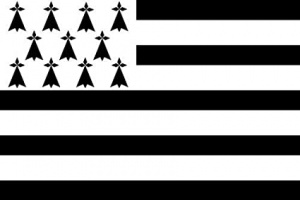Language/Breton/Vocabulary/Count-to-10
Hi Breton learners! 😊
In this lesson, we will learn how to count to 10 in Breton, one of the six Celtic languages still spoken today.
Breton is spoken mainly in Brittany, in the northwest of France. The language has a rich cultural heritage, and it is an important part of Breton identity. Through this lesson, we will also discover some cultural facts about Brittany.
Let's start by looking at the numbers from 1 to 10:
Take a moment to explore these relevant pages as you conclude this lesson: Usual expressions and words in Breton, Animals, House & Sports, Hobbies and Games.
Breton Numbers[edit | edit source]
| Breton | Pronunciation | English |
|---|---|---|
| un | [œn] | One |
| daou | [ˈd̪ɔw] | Two |
| tri | [tri] | Three |
| pevar | [ˈpɛv̟aʁ] | Four |
| pemp | [pɛmp] | Five |
| c'hwec'h | [kʷɛxs] | Six |
| seizh | [sɛz] | Seven |
| eizh | [ez] | Eight |
| nav | [nav] | Nine |
| dek | [dɛk] | Ten |
As you can see, some numbers in Breton can be quite long and difficult to pronounce, such as c'hwec'h, which means six. To make it a bit easier, you can use analogies to remember the numbers. For example, you can think of pevar (four) as resembling the word "quatre" in French or "four" in English. Another way is to remember that tri (three) is similar to "tree", which also has "three" letters.
Now that we know how to count to ten, let's see some examples in context:
Dialogue[edit | edit source]
- Person 1: Un! (One!)
- Person 2: Daou! (Two!)
- Person 1: Tri vrastad plijadur ha pemp livadennou. (Three delicious cakes and five apples.)
- Person 2: C'hwec'h kig ha seizh legumaj. (Six pieces of meat and seven vegetables.)
- Person 1: Eizh a zo an holl zokennoù bremañ. (Eight are all the things now.)
- Person 2: Nav den a zo en ti. (Nine people are in the house.)
- Person 1: Dek munut war-dro c'hwarter. (Ten minutes around a quarter.)
You may have noticed that some numbers change depending on the gender of the noun they refer to. For example, pemp (five) can become c'hwezh with feminine nouns. Don't worry too much about it for now, we will cover it in more detail in another lesson.
That's it for this lesson on counting to 10 in Breton! Practice saying the numbers out loud, and try to use them in context as much as possible. To improve your Breton Vocabulary, you can also use the Polyglot Club website. Find native speakers and ask them any questions!
Brittany Facts[edit | edit source]
Brittany is a fascinating region with a rich cultural heritage. Here are some interesting facts about Brittany:
Historical Sites[edit | edit source]
Brittany has a long and fascinating history that is reflected in its many historical sites. Some of the most famous ones include the Carnac stones, which are prehistoric megaliths dating back to 4500 B.C., and the Mont Saint-Michel, a beautiful abbey and fortress located on a tidal island.
Festivals[edit | edit source]
Brittany is also known for its colorful festivals, which take place throughout the year. The Festival Interceltique de Lorient, for example, is one of the largest Celtic festivals in the world, attracting more than 700,000 visitors each year.
Food[edit | edit source]
Breton cuisine is renowned for its seafood, crepes, and buttery pastries. Some of the most famous Breton dishes include kouign-amann, a caramelized butter pastry, and galettes, savory buckwheat crepes filled with a variety of ingredients.
Sources[edit | edit source]
➡ If you have any questions, please ask them in the comments section below.
➡ Feel free to edit this wiki page if you think it can be improved. 😎
Other Lessons[edit | edit source]
- Numbers
- Days of the week
- Food
- Education
- Post office
- Sports, Hobbies and Games
- Vegetables
- Weather and Climate
- Drinks
- Geography

